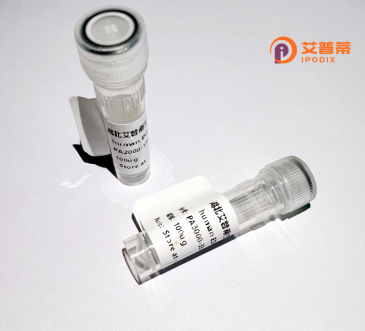
| 纯度 | >90%SDS-PAGE. |
| 种属 | Human |
| 靶点 | COL25A1 |
| Uniprot No | Q9BXS0 |
| 内毒素 | < 0.01EU/μg |
| 表达宿主 | E.coli |
| 表达区间 | 1-496aa |
| 氨基酸序列 | MLLKKHAGKGGGREPRSEDPTPAEQHCARTMPPCAVLAALLSVVAVVSCLYLGVKTNDLQARIAALESAKGAPSIHLLPDTLDHLKTMVQEKVERLLAQKSYEHMAKIRIAREAPSECNCPAGPPGKRGKRGRRGESGPPGQPGPQGPPGPKGDKGEQGDQGPRGPLGPPGQKGSIGAPGIPGMNGQKGEPGLPGAVGQNGIPGPKGEPGEQGEKGDAGENGPKGDTGEKGDPGSSAAGIKGEPGESGRPGQKGEPGLPGLPGLPGIKGEPGFIGPQGEPGLPGLPGTKGERGEAGPPGRGERGEPGAPGPKGKQGESGTRGPKGSKGDRGEKGDSGAQGPRGPPGQKGDQGATEIIDYNGNLHEALQRITTLTVTGPPGPPGPQGLQGTKGEQGSPGIPGMDGEQGLKGSKGDMGDPGSQWNERRKRRFWNAGSTGSFYHRPTRPTRSPWPTWPHGTSWTSWTKGSIWLRRKARIPGYRWSYGTPWPCRSQRRKR |
| 分子量 | 77.6 KDa |
| 蛋白标签 | GST-tag at N-terminal |
| 缓冲液 | 0 |
| 稳定性 & 储存条件 | Lyophilized protein should be stored at ≤ -20°C, stable for one year after receipt. Reconstituted protein solution can be stored at 2-8°C for 2-7 days. Aliquots of reconstituted samples are stable at ≤ -20°C for 3 months. |
| 复溶 | Always centrifuge tubes before opening.Do not mix by vortex or pipetting. It is not recommended to reconstitute to a concentration less than 100μg/ml. Dissolve the lyophilized protein in distilled water. Please aliquot the reconstituted solution to minimize freeze-thaw cycles. |
以下提供的是基于领域知识的示例性参考文献框架,建议通过学术数据库进一步核实具体文献:
1. **文献名称**: "Characterization of recombinant human collagen XXV (COL25A1) and its role in amyloid-beta aggregation"
**作者**: Mörgelin M, et al.
**摘要**: 研究通过哺乳动物细胞系统重组表达了人COL25A1蛋白,分析了其结构特征,并发现该蛋白可能通过结合β-淀粉样蛋白促进阿尔茨海默病斑块形成。
2. **文献名称**: "Expression and purification of COL25A1 in HEK293 cells for functional studies"
**作者**: Khew-Goodall Y, Aricescu AR.
**摘要**: 报道了使用HEK293细胞高效表达重组人COL25A1的方法,优化了纯化流程,并验证了其在体外支持神经元黏附的功能。
3. **文献名称**: "COL25A1 mutations disrupt extracellular matrix assembly and cause brain morphology defects"
**作者**: Kakuda S, et al.
**摘要**: 通过基因编辑技术构建COL25A1突变体,发现其异常表达导致细胞外基质结构紊乱,并与先天性脑发育异常相关。
4. **文献名称**: "Proteomic analysis reveals COL25A1 as a novel component of the blood-brain barrier"
**作者**: Söderberg O, et al.
**摘要**: 利用蛋白质组学鉴定COL25A1在血脑屏障中的特异性表达,提示其可能参与屏障完整性调控。
---
**备注**:以上内容为示例性质,实际文献需通过PubMed、Google Scholar等平台以“COL25A1”、“recombinant collagen XXV”等关键词检索确认。关注近年发表(如2015年后)及高被引论文可提高准确性。
The recombinant human COL25A1 protein is derived from the α1 chain of type XXV collagen, a unique transmembrane collagen primarily expressed in neuronal and endothelial cells. Unlike classical fibrillar collagens, COL25A1 features a short collagenous domain flanked by non-collagenous regions and forms homotrimers via its triple-helical structure. It plays critical roles in tissue organization, particularly in basement membrane stabilization, cell adhesion, and nervous system development. Studies suggest its involvement in neurological pathologies, including Alzheimer’s disease, where COL25A1 co-localizes with amyloid-β plaques, potentially influencing plaque formation and neuronal toxicity.
Producing recombinant COL25A1 requires mammalian or insect expression systems to ensure proper post-translational modifications, such as proline hydroxylation, essential for structural stability. Purification often employs affinity tags or collagen-specific binding methods. The recombinant protein enables in vitro studies of its interactions with extracellular matrix components, neuronal receptors, or pathological aggregates. It also aids in exploring COL25A1's role in cancer progression, as its overexpression in glioblastoma and other tumors correlates with blood-brain barrier disruption and invasive phenotypes.
Despite its significance, challenges persist in mimicking native folding and oligomerization. Current research focuses on optimizing expression protocols and characterizing COL25A1’s functional domains to develop targeted therapies for neurodegenerative diseases and cancer.
×